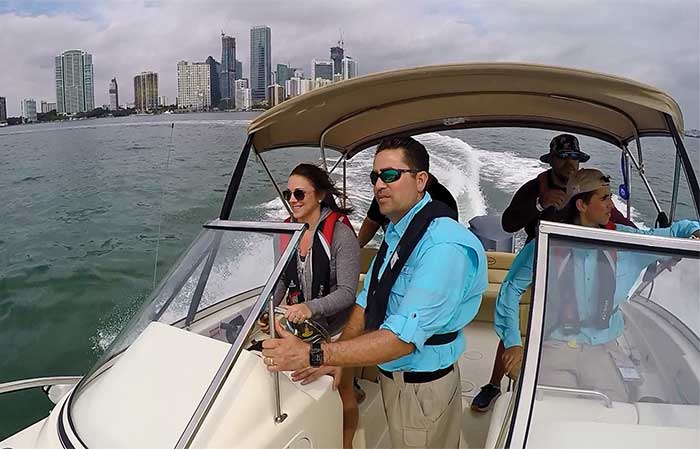Advertisement
Launched five years ago, our On-Water Training program weathered the pandemic and is throttling up, so climb aboard!

Here at BoatUS, we strive to help each of our 800,000-plus Members become the most sea-savvy, knowledgeable, and safe boaters on their home waters. Five years ago, we saw a gap in marine services, leading us to create an innovative program designed to cultivate more safe boaters on the water.
"We developed consistent, affordable, and available on-water powerboat instruction at the national level," says Alan Dennison, the Coast Guard-licensed captain who manages our On-Water Training program. "The biggest barriers to boating are access and experience. People didn't know how to get out on a boat and/or didn't know how to drive one. We've created a solution for that."
Some Members don't realize that our BoatUS Foundation, while a close member of our BoatUS family, is a separate nonprofit organization created, in part, to promote safe and responsible boating. Beyond the informative articles on boat handling and seamanship you read in BoatUS Magazine, the Foundation addresses educating boaters on an individual level by offering more than a dozen online boating safety courses. This on-water training effort by our Foundation has taken our online education to the next level.
How It Works
"We want training to be available and affordable for those who just want to try boating, as well as to those who want to refine their existing boat-handling skills," Dennison says. "We offer a modular curriculum so people can take the courses in bite-sized chunks, rather than committing to longer courses that are more expensive."
Ranging from $149 to $249, the three-hour courses on basic powerboating, docking, open-water handling, and advanced maneuvering typically take place aboard an 18- to 26-foot powerboat, with three to four students taught by a U.S. Coast Guard-licensed captain. With only three hours to teach, each course is efficiently packed, but students still get sufficient time at the helm.
Students generally learn aboard center- or dual-consoles, or bowriders, with either outboard or sterndrive motors. BoatUS requires all instructors to hold a U.S. Coast Guard captain's license. The on-water program follows a curriculum developed by the National Safe Boating Council. It is broken down into four separate three-hour courses starting with "Introduction to Boating," which goes over boat functions and features and how to drive the boat safely.
"Precision Docking and Boat Handling" builds off what the student learns in the intro course but focuses primarily on close-quarters maneuvering and operating around fixed objects such as docks — one of the most stressful parts of boating.
Advertisement
"Open Water Boat Handling" teaches students about getting a boat onto plane, boat trim, and safety procedures for the skipper and others onboard. The final module offered, "Open Water Advanced Maneuvering," focuses on maneuvering on plane, crossing wakes, and man overboard procedures.
Students who finish all four modules of the NSBC curriculum are well-grounded in the National On-Water Standards (NOWS), quality standards that provide instruction to beginner-level students who are building skills to operate recreational powerboats, sailboats, and human-propelled craft. NOWS represent a national consensus of recreational boating experts from across the country.
Who Is This For?
"We get students who've never stepped foot on a boat of any kind, as well as people who've been boating for years," Dennison says. "Some just want to try boating for the first time but don't have access to a boat. Others want to learn from a professional instructor. Some are boat owners who are still uncomfortable with close-quarters boat handling."
A participant survey of about 900 people who took the course shows that gaining confidence and experience is the most common reason for taking a course, and 80% say they're very likely to take another hands-on boating course.
How Can I Find A Course?
At press time, the BoatUS On-Water Training program had 15 partners, including existing training schools, dealerships, and national and local boat clubs. The East Coast is well covered with partner locations in Florida, Maryland, New Jersey, Virginia, Georgia, North and South Carolina, Connecticut, Rhode Island, and Massachusetts.
"We recently opened up training in San Diego at the Coast Guard-approved Training Resources Maritime Institute's BoaterU program," Dennison says. "We're looking to expand training facilities on the West Coast, Great Lakes, and Texas, then work our way inland from there. We want to be available to everyone who wants to learn about boating." Visit BoatUS.org/On-Water for dates and locations.
